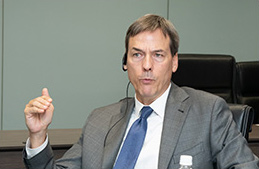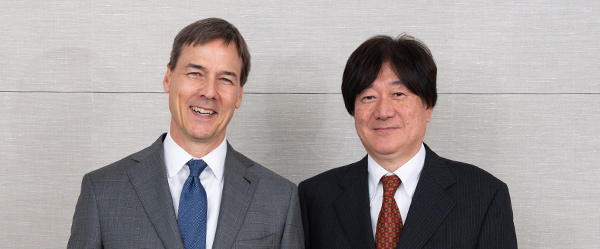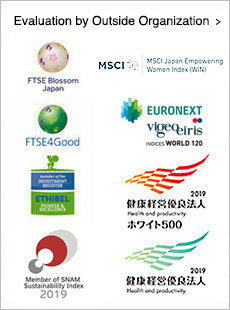What is “Differentiated Materiality”?
Considering Business Fields and Management Foundation as a Dualism
- Looked at from the standpoint of an investor, JSR’s materiality is extremely clear. I think there are many social issues that can be grasped in life sciences, such as contribution to lower medical costs by greatly improving the efficiency of new drug development. And fuel-efficient tires can undoubtedly contribute to climate change countermeasures. If you say that “issues tied to better quality of life in society are our materiality and also the SDGs that we should commit to,” then I think you will have a very clear message.

- Kuroda:
- I also found it very easy to understand. Going further, because there is no need for JSR Group to resolve all issues alone, I think “Partnerships”—the seventeenth goal of the SDGs—should also be considered. For example, external partnerships that involve, say, using other company’s technologies or collaboration are important in addressing microplastics. There should be no need to solve everything on your own.
Another approach is to use the SDGs not only in positive strategic aspects but also in improving areas that tend to swing in a negative direction, such as diversity and industrial safety. In the case of Japanese companies in particular, no matter how much they promote women’s participation and the like, those efforts don’t produce results. So they need to say what kind of future strategy they have concerning the ratio of female directors, for example, even if they currently have no female directors. So, in this sense, it may be better to show the “business fields” portion and “management foundation” portion separately when considering materiality. - That is exactly a point I wanted to make. “Business fields” and “management foundation” should be considered separately. No matter how much financial growth it achieves, if a company has weak corporate governance or holes in its compliance, it will attract social criticism. Thinking of the management foundation that supports the company’s strength and the business fields that enhance its strength as a dualism, and then incorporating diversity, human rights, human resources development, and the like into the management foundation will make the company’s strength stand out even more. I think this will fit in very nicely when you speak about JSR Group’s materiality.
- Fujii:
- Speaking of what make up the core competencies of JSR Group, I think one is human resources. If we consider what supports business reform that meets social needs, it is human resources that can adapt to various changes in the business environment.
Looking at JSR’s business, when our business expanded from petrochemical products business to what was then called “fine chemicals” business and then further to life sciences business, which is happening now, our human resources-generating corporate culture and human capital have allowed us to make the necessary adaptations. Diversity and human rights are listed as risk items in JSR’s current materiality classifications. However, I think that such human capital is actually a “strength.” So I felt we should highlight this point a bit more. In our materiality, I want to bring more attention to the fact that our human resources development capabilities, which produce people capable of adapting to business globalization and to changing business structures, are a strength of our company. - Kuroda:
- When I speak with people from Japanese companies, the subject of human resources development often comes up. But usually the discussion is premised on talented employees’ coming into the company. As Japan’s birthrate falls and its society ages, it will become more difficult to secure human resources. So, although human resources development is important, I get the sense that the time will arrive when hiring high-quality human resources will also become a candidate for materiality.
- Kawahashi:
- As you say, when it comes to human resources, attention almost always goes to development. JSR also has many training programs and curricula for all levels. We are constantly working to make changes that are appropriate for the times by suitably modifying our educational programs as circumstances demand. But recently we have also been very conscious about acquiring talented human resources. In our case, hiring people with advanced knowledge and know-how in life sciences, materials informatics,* and other fields has become particularly problematic. We need to reexamine this issue, beginning with our personnel assessment system and compensation system. We are currently beginning this discussion by going back to that point.
* Materials Informatics: A method to efficiently search for new materials and alternative materials through information science.

The Importance of Expressing Impact Quantitatively
- Shimizu:
- When responding to SDGs is required, actions such as “SDGs wash”* also arise. But even when no such intent exists, there is the risk that people will say “what you’re doing differs from what the SDGs are supposed to be about.” How should we avoid that risk? If you know of any useful examples or perspectives from other companies, even overseas companies, would you mind sharing them with us here?
* SDGs wash: The taking of only superficial steps to address the SDGs
- Recently, the EU Commission has been preparing a catalogue that delineates what is an activity compatible with sustainability and what is not. It appears that, ultimately, the catalogue will be used to prepare ISO standards. So I asked, “If even the question of what constitutes sustainability will be decided by the ISO, won’t this eliminate originality and obstruct innovation?” But it seems they think that delineation is necessary to secure the minimum level of transparency, as not doing so will result in just “green wash” and “SDGs wash.” There is no doubt that international opinion is moving toward stricter rules.
The point of “impact” that I mentioned earlier seems to be a focus of debate in Europe, and how to express impact will be the key. Methods for measuring impact are currently being discussed, and various proposals are being put forward. The gist is that, in order to judge what is sustainable and whether or not something truly makes a contribution, it is important to disclose the impact of activities continuously in accordance with international rules. I think this will probably come together within the question of how to measure impact.
What this means is that measuring the impact brought by a product or activity as quantitative data and then preparing designs that will facilitate analysis later will be effective as a means of deciding what constitutes materiality. Because no means for quantification have been available, we have thus far generally talked in qualitative terms. However, if you can confirm positive effects as numerical values based on impact analysis conducted in line with established methods, you should be able to avoid accusations of “SDGs wash.” - Shimizu:
- There have been various attempts at quantification. Examples include LCA* and carbon footprint.* But it seems to me that these efforts have somehow lost momentum. I have some concern that quantitative evaluation of the SDGs will also fade away in five years or so. But considering that SRI (Socially Responsible Investment) has finally taken root after twenty years, it takes a certain amount of time before these things become socially recognized and established. So we may have to approach the SDGs with the same mindset.
* LCA: Abbreviation of Life Cycle Assessment. A method of quantitatively analyzing and assessing a product’s environmental impact throughout its entire life cycle.
* Carbon footprint: The total amount of living- and activity-related greenhouse gasses emitted by individuals, organizations, and companies after conversion into CO2.
- That is because finally, even in Japan, investors are making long-term investments, such as ESG investments, after gauging which companies can create value over the long term.
- Shimizu:
- No matter the industry, there are giant companies that lead major trends. For example, things can change suddenly the moment such a company declares it will no longer use products derived from fossil fuels. Looked at in this light, it’s possible that, in the case of JSR, there is greater risk of market change in the digital solutions field than in the petrochemical field.
- Johnson:
- That’s right. One of JSR’s major customers in North America is Intel, which is a leading company in the digital field. One advantage of doing business with Intel is that we can quickly learn of possible industrial trends of the future. Intel has firm diversity guidelines and recently publicly announced that men and women will receive equal pay. It also presents strong statements for both financial and non-financial matters in its annual report. And most importantly, it clearly states that it emphasizes ESG in its relationship with vendors. So I think partnering with giant companies like Intel is an advantage, not a risk.
- Fujii:
- Where do you see the difference between Japan and the United States?
- Johnson:
- Much of the U.S. business environment is polarized right now, and thinking concerning climate change is no exception. Specifically, a general shift has been taking place recently, and I think that, right now, the U.S. is standing at a crossroads from which major change is about to take place.
My feeling is that people of the world see many challenges before them. This is causing them vague anxieties and leading to emotional responses. In this kind of social environment, I think it is very important for JSR Group to think about how it will fulfill its own responsibilities as a company and how it will convey its intent to do so.

Incorporating Materiality into Business Schemes
- So it becomes necessary to analyze risk and opportunity in each business field in that sense as well. But, even now, I think that, in JSR’s case, your orientation toward realizing this as a business and the social value that it generates are being very clearly demonstrated. On the other hand, demonstrating the impact of social value with the KPIs* is necessary to avoid being accused of practicing “SDGs wash.” Through our discussion so far, I feel a good approach might be to discuss this matter with attention to international trends concerning impact measurement, with an eye to ensuring that the KPIs do not become self-directed, and then to present a strategy.
* KPI: Abbreviation of Key Performance Indicator. An indicator for quantitatively assessing an individual’s or department’s progress toward a goal within a company or other organization.
- Shimizu:
- Mr. Takegahara has given us some valuable comments. He noted that we should indicate impact quantitatively and explained how investors look at companies. Ms. Kuroda has said that we need not commit to all of the SDGs. Their insights made us realize the importance of ranking our priority ourselves and, indeed, the extremely heavy responsibility we bear in doing so.
- Fujii:
- My department will be in charge of disclosing non-financial information, something that will be a significant issue going forward. So from that standpoint, I reaffirmed my desire to support JSR Group in its entirety by explaining and sharing how our activities contribute to a sustainable society in easy-to-understand terms.
- Shimizu:
- I was reminded of the importance of three things during the discussion today. The first is “execution.” The point here is how to make a contribution toward actually realizing the SDGs within business activities, rather than just using them as a slogan. Companies that operate globally across national borders play extremely important roles, and thus execution is, in itself, a social responsibility that is imposed upon us. The second is “priority.” Specifically, it is important to steadfastly set and verify priorities. And the third is “literacy.” The question here is how to improve the literacy of all, including employees, vis-a-vis the SDGs’ concept and the social issues before us.
- Kawahashi:
- The thing that particularly struck me in today’s dialogue was the point about quantifying impact. Without it, JSR’s policies will not take shape and the PDCA cycle will not work as it should. By all means, this point should made part of future discussions concerning the formulation of materiality.
I was also impressed by the remarks concerning the importance of discussing business fields and management foundation separately and of preparing their policies independently. The point that logically explaining them becomes impossible if they are mixed together really struck me. From now on, I intend to arrange our company’s materiality with awareness of this point in order to ultimately produce a uniform policy for JSR. - Johnson:
- Whether it’s CSR or the SDGs, seeing them as peripheral to business will lead to failure. If they become superficial efforts made simply for publication in reports, they will end up being a waste of time and resources. Likewise, pretending that we can achieve all 17 of the SDGs or that we can set all as priorities will also be meaningless.
- That’s exactly right. Stakeholders do not want a summary of activities. They want to know if JSR Group has a strategy that can properly measure and present actual impacts to be brought by its technologies and innovation. That should become an important message in your next materiality.
- Johnson:
 Through our discussion today, we gained a good appreciation of the importance of setting priorities in materiality. But more than that, we understood that those priorities will be meaningless unless they are thoroughly absorbed into our business schemes.
Through our discussion today, we gained a good appreciation of the importance of setting priorities in materiality. But more than that, we understood that those priorities will be meaningless unless they are thoroughly absorbed into our business schemes.
The first thing that is necessary here is literacy. This means firmly understanding the business environment, social environment, and technical environment. The second is quantifying and measuring goals based on that understanding. If we cannot do this, we will be unable to present clear actions later. Having understanding and then quantifying impact makes it possible to apply the PDCA cycle. From there, necessary actions will become apparent and, at the same time, accountability will become clear. Only then can we make a commitment to our stakeholders. We will be able to tell them how we intend to grow and thrive by presenting a convincing story. I firmly believe that, if we can do that, we will be attractive to highly talented personnel. I further believe we will be able to establish healthy cycles in all areas, including in building the best possible relationship with our customers.
Thank you very much for this wonderful discussion time and your valuable opinions.



